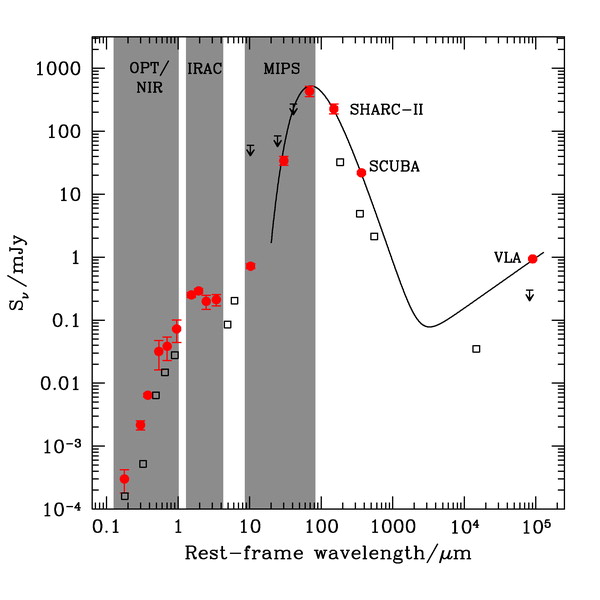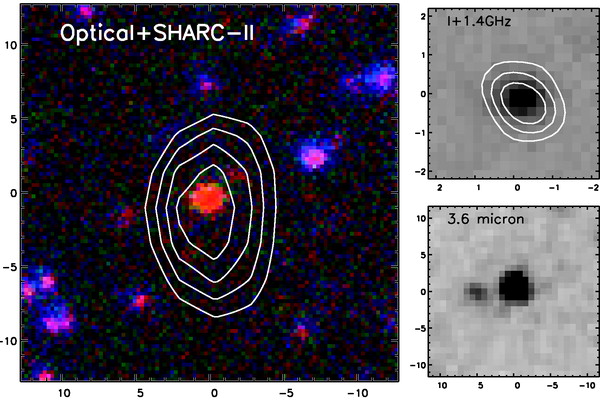
 Hyperluminous
Starburst Galaxy captured with SHARCII
Hyperluminous
Starburst Galaxy captured with SHARCII

Thanks
to the
millimeter/submillimeter sensitive instruments such as SCUBA, SHARCII,
Bolocam, and MAMBO, we have learned much about the role that dust plays
while galaxies are forming. But, to constrain the important
parameters such as total amount of dust, its luminosity and
temperature, we need to measure how bright a galaxy is across a broad
wavelength range in order to trace out its Spectral Energy Distribution
(SED, see Fig 1 shown below). Unfortunately, the submillimeter
measurements typically lie at wavelengths longer than the SED
peak. The Spitzer Space Telescope however, is sensitive to the
shorter wavelengths, hence there is a natural synergy between
ground-based submillimeter cameras and those on Spitzer. At the
CSO, we have been using the SHARCII camera to study objects detected in
a large Spitzer survey in the constellation Bootes. Our first
observation (See Fig 2 below) discovered a particularly luminous
galaxy, which appears to be powered by an amazing burst of star
formation. There is another galaxy directly between us and this
target, which may be amplifying the brightness through a phenomenon
called gravitational lensing. We are now working on new
observations to better understand this rare and luminous galaxy, which
we see today as it appeared over 7 billion years ago, when the Universe
was less than half of its current age.
This result was
published by Borys
et al 2006 in Astrophysical Journal.

Figure 1: Spectral Energy Distribution of MIPS J142824.0+352619,
the source detected by the CSO and Spitzer. In this figure,
we plot as red points the actual measurements taken from a host
of ground and space-based observatories. The black line is
a fit to the part of the SED dominated by dust, which is by far
the most luminous part. The three grey regions denote three
different wavelength ranges: First the optical, which is the part
of the spectrum our eyes are sensitive too. Second is the
IRAC camera on Spitzer, which is sensitive to the light from
older stars in a galaxy, and finally MIPS, which is camera
sensitive to the dust which we also see with the CSO.

Figure 2: 30"x30" false color image of MIPS J142824.0+352619
with the SHARC-II flux contours overlaid. Interestingly,
the object is the reddest galaxy in the vicinity. In the
top right panel, we zoom in on the object, and instead of
overlaying SHARC-II data, use radio imaging. Radio data is
a good proxy for the source of the sub-mm emission, hence it is
clear that the dust we observe with SHARC-II is constrained to
the single galaxy in the middle of the field. The lower
right panel is another close-up, but this time shows an image
from the IRAC camera on Spitzer. Note the interesting
companion galaxy to the left of the central source. Whether
this is part of a merging system, or indicative of the
gravitational lensing, is still unknown.

 Hyperluminous
Starburst Galaxy captured with SHARCII
Hyperluminous
Starburst Galaxy captured with SHARCII


 Hyperluminous
Starburst Galaxy captured with SHARCII
Hyperluminous
Starburst Galaxy captured with SHARCII


